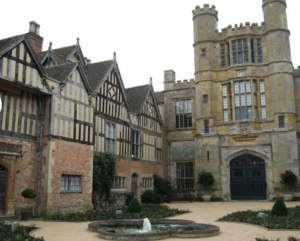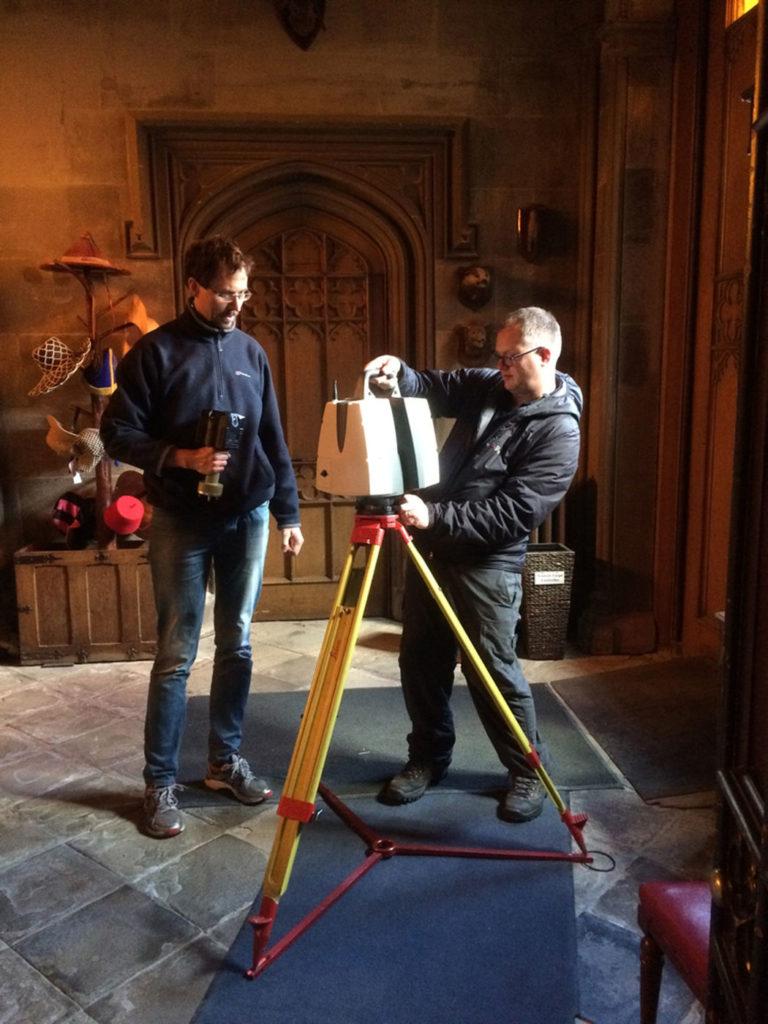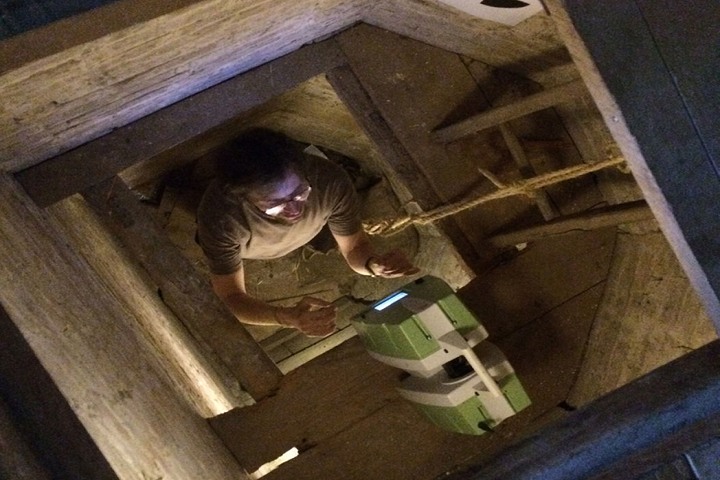University of Nottingham Researchers Use 3D Scanning to Reveal Secrets of Hidden Priest Hole Chamber in Tudor Mansion
 Two years ago, the University of Nottingham in the UK received funding for a lab filled with analysis equipment and roughly £2.7 million worth of 3D printing equipment. It’s not just for anyone: the lab’s main priority is for scientists from the Additive Manufacturing and 3D Printing Research Group (3DPRG) to study 3D printing in the pharmaceutical field. But engineers with 3DPRG have been hard at work developing new additive manufacturing processes to make cars more fuel efficient and less noisy, and some of the leading members of Curious Travellers, an organization aiming to protect culturally important and historic relics through 3D models, are from the university. In a similar field with this last project, scientists from the university’s Department of Archaeology recently used 3D laser scanners to uncover secrets of a hidden room in a Warwickshire mansion.
Two years ago, the University of Nottingham in the UK received funding for a lab filled with analysis equipment and roughly £2.7 million worth of 3D printing equipment. It’s not just for anyone: the lab’s main priority is for scientists from the Additive Manufacturing and 3D Printing Research Group (3DPRG) to study 3D printing in the pharmaceutical field. But engineers with 3DPRG have been hard at work developing new additive manufacturing processes to make cars more fuel efficient and less noisy, and some of the leading members of Curious Travellers, an organization aiming to protect culturally important and historic relics through 3D models, are from the university. In a similar field with this last project, scientists from the university’s Department of Archaeology recently used 3D laser scanners to uncover secrets of a hidden room in a Warwickshire mansion.

Coughton Court is now owned by the British heritage charity National Trust, which keeps it open to the public for much of the year as an historic building.
Looking at this gorgeous English Tudor mansion, called Coughton Court, you can just imagine there are all sorts of secrets hidden inside. This particular study was funded by Britain’s National Lottery and revealed more information about a hidden tower room in the mansion’s gatehouse, called a priest hole, which was used as a hiding place for 16th and 17th century priests during anti-Catholic persecutions. According to Christopher King, one of the lead study researchers and an assistant professor in the Department of Archaeology, Catholic priests at this time were considered to be traitors under English law.
Many priests faced grave danger by traveling around England in disguise to perform secret, banned ceremonies at wealthy country homes like Coughton Court; they faced execution if caught. The priest holes were built between floors and inside walls, so the families could hide priests from murderous search parties. The Coughton Court priest hole was discovered by later owners of the home in the 1850s.
King said, “We know that priests were hiding in these spaces for up to three days while people were searching the properties, and some of them are really very small, where the priest would be in quite an enclosed box-like space.”

To show the surrounding structure of the house, archaeologist Chris King (right) and mapping specialist Lucasz Bonenberg (left) laser-scanned the interiors of all the rooms in the building, as well as the exteriors and the surrounding grounds.
King and the other researchers used 3D LIDAR laser scanning equipment to map the priest hole and other secret chambers in the house, to determine where they were located in relation to the rest of the building and its grounds. Using Leica 3D laser scanners, they discovered something fascinating from the composite images and 3D computer models: the chamber was built using what’s known as a double-blind construction, so search parties would be fooled into thinking they’d found an empty chamber.
“When they’re searching, they think they’ve found the priest hole but it’s empty, but actually the priest is hidden in the more concealed space beyond. And that’s what happens at Coughton: there’s one chamber under the floor in the turret of the tower, and then there is another trap door that goes through into a second space, which we assume is where the priest was actually hiding,” said King.
The priest hole presented a unique challenge for King and Lukasz Bonenberg, a geodesy and mapping specialist with the university’s Geospatial Institute.
“They are quite narrow, probably about a meter [3.3 feet] across, and quite tall and thin,” said King. “It was difficult to get the scanner in there, and Lukasz ended up spending a couple of hours down there with the equipment, basically because he’s the skinniest.”
King went on to explain another secret of Coughton Court. The mansion played an important role in what’s known as the Gunpowder Plot: a failed assassination attempt of King James I in 1605 that was inspired by Catholic resentment over the country’s anti-Catholic laws. The plan was to blow up the House of Lords at Westminster, while the king and his government ministers were there. One of the conspirators, Sir Everard Digby, rented Coughton Court as a family home, and on the agreed upon assassination date of November 5 (now known as Guy Fawkes Day, or Bonfire Night, in the UK), a group of the leading conspirators met there to await news. But they all ran away when a messenger came and said that the plot had been discovered; many were later captured and executed.

To reveal how the priest hole was constructed inside the pre-existing structure of the building, the researchers made precise 3D maps of the interior of the secret space with a Leica laser scanner.
The UK heritage charity National Trust currently owns Coughton Court and keeps the majority of the property open to the public, including the tower where the priest hole is located. However, the actual tower is generally not accessible to most people, so it’s great that the research team was able to scan the entire mansion, inside and out, as well as its grounds, with terrestrial laser scanning.
According to Bonenberg, “Terrestrial laser scanning is an important new technology for recording ancient monuments as they capture a huge amount of data very quickly and this is the first time that TLS has been used for the purpose of visualising hidden spaces inside Tudor houses.”
![At Coughton, the priest-hole is hidden away out of sight and the 3D model will really help visitors to understand where it fits inside the building. Scan pictured [Image: Daily Mail, via University of Nottingham]](https://3dprint.com/wp-content/uploads/2017/02/TLS-of-Coughton.jpg)
At Coughton, the priest-hole is hidden away out of sight and the 3D model will really help visitors to understand where it fits inside the building.
King said, “The scans and the fly-throughs that we’ve created will be really good for people who can’t get up the stairs to the priest hole – you can stand in the courtyard with these images and it really helps you visualize where the space is.”
There are thought to be around 30 priest holes in existence, he added, but many are not open to the public and are deliberately difficult to access.
“That’s really important from a public outreach point of view: making sure that visitors are aware of these spaces and their very interesting histories, and, hopefully, getting people interested in the stories associated with the buildings.”
Discuss in the Hidden Priest Chamber forum at 3DPB.com.
- Historians think the priest hole at Coughton Court was built late in the 16th century by Nicholas Owen, a celebrated English Catholic spy, artificer and escape artist who is thought to have built more than 20 priest holes in the country houses of Catholic families around England.
- The 3D data from the laser scans has been combined to create a 3D model of the entire building that reveals how the secret priest hole (shown here in color) was hidden inside the pre-existing structure.
- The scans show the “double blind” construction of the hidden space (shown here in orange, beneath the entrance to the turret, shown in green), which was designed to fool searchers into thinking they had discovered an empty priest hole. But the priest could be hiding in a second secret space (shown here in blue and light blue) below a trap door in the upper priest hole.
Subscribe to Our Email Newsletter
Stay up-to-date on all the latest news from the 3D printing industry and receive information and offers from third party vendors.
Print Services
You May Also Like
3D Printing Financials: Prodways Ends 2024 with a Profit
After a tough couple of years, Prodways (EPA: PWG) is starting to bounce back. The French 3D printing company finally made a profit in 2024, improved its operating performance, and...
Blue Origin & Auburn University Use EOS M290 to Study Copper 3D Printing
Blue Origin, the commercial space company built off of investments from Amazon founder Jeff Bezos, has donated two EOS M290 powder bed fusion (PBF) printers to Auburn University’s National Center...
Rocket Lab to Acquire Restructured Laser Communications Provider Mynaric AG
Rocket Lab USA, the Long Beach-based, end-to-end space services company that specializes in producing rockets with additive manufacturing (AM), has announced plans to acquire Mynaric AG, a German provider laser...
3D Printing Financials: Stratasys Ends 2024 with Cost Cuts and Growth Plans
Stratasys (Nasdaq: SSYS) has wrapped up 2024 with stronger margins but a full-year net loss. The polymer 3D printing leader navigated a year of economic headwinds, restructuring efforts, and shifting...






























